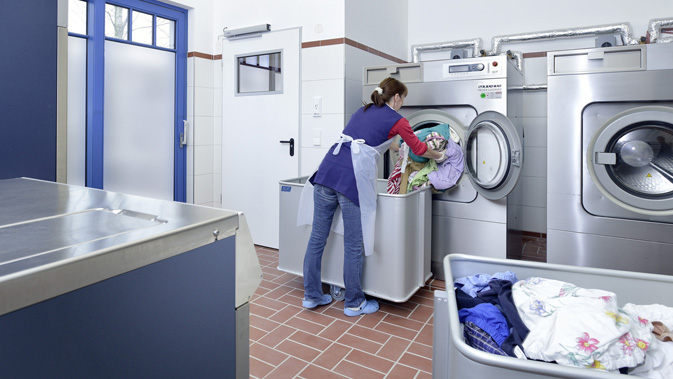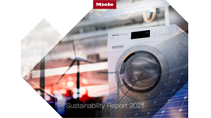Press releases
Central laundry serving four care homes places trusts in Miele

Top quality and best equipment
The managing director of the new laundry run by G&W Service in the German town of Burgdorf, Gaurav Garg, is 'pretty proud' of his business. It meets all the requirements of a modern laundry and workplace. The laundry is currently designed to cope with 1 tonne of textiles per week. Residents' personal laundry from a total of four affiliated old-age care and nursing homes run by the organisation as well as other types of laundry are washed here. The laundry has been in operation since November 2014.
Previously, the laundry was processed decentrally in the individual homes. Exploiting synergistic benefits and better machine utilisation were the main reasons for setting up a central laundry. And, by a stroke of luck, a plot of land was already available on a commercial park in the south of the town where the central kitchen was already located. So, an extension was built, tailored to the needs of a modern laundry.
Uppermost in the director's mind was the need to plan workflow, ensure a lean operation, install top-class equipment, implement energy-saving measures, achieve sustainable quality and ensure safety. 'In setting up the laundry we paid close attention to top quality and only used the best equipment', Gaurav Garg explains. This principle also finds expression in the building itself in the form of brightly lit and high-ceilinged rooms letting in ample daylight and allowing outside access.
When it came to the laundry machines, the operator decided to go for Miele for reasons of quality. The three electrically heated washer-extractors, each with a 32 kg load capacity, are connected to a hot water supply. A gas-fired central heating system with a 120 kW rating provides 60°C hot water. Given the specific price of gas and electricity, this cuts costs by up to 60% compared with a cold water fill as the hot water is heated using gas. The hot water connection also cuts cycle times by up to 25%. The two energy-efficient 20 kg gas dryers have been integrated into a heat recovery system: 'Hot waste air is captured by a stainless-steel canopy and released to atmosphere. The same ducting system introduces fresh air for the drying process which passes along the stainless-steel pipe as it enters and is heated in the process. This saves heating energy', the managing director explains.
Each laundry item systematically recorded
The laundry washes towelling, bedspreads, curtains, duvet covers, pillowslips, protective bags for laundry and clothing, covers for transport crates and tea-cloths from the homes as well as floor mops. Residents' personal laundry is also catered for, from socks to underwear right through to expensive pullovers. And to ensure that each item finds its way back to its rightful owner, the laundry, managed by Bettina Tabbert, has come up with a smart system: The laundry is delivered in sacks, with one sack for each resident. On receipt, each labelled item is scanned. The barcode contains information on the owner, the type of item, its colour, and even which programme it should be washed in. Items not yet registered are entered on the system and fitted with a patch, making them unique and eliminating the risk of mix-ups. The next step involves sorting laundry before it enters the washing area. This is where machine loads are weighed so as to ensure the precise dispensing of powder detergent before the laundry wings its way into one of the three washer-disinfectors.
The washing and drying operations are separated by a diaphragm wall. 'We have installed a differential pressure system. Air is extracted from the contaminated side and so access to the drying room is via a sluice.' Managing Director Garg is pleased that the health authorities approved this approach as it gave him far greater freedom in designing the 250 m² laundry.
Thorough sorting of laundry
'All items are tumble-dried', say Tabbert, the laundry manageress, and particular attention is paid to materials when sorting textiles. 'After all, the programmes are designed for specific textiles. Woollen pullovers are for example only dried briefly and then hung to complete drying on hangers', she continues. Where necessary, blouses for instance are ironed. And finally, each item of personal laundry is once again scanned and read out of the system. The scanners are linked to the in-house IT system which automatically assigns space to items in the mobile shelf units. Here, Bettina Tabbert has introduced a method which allocates shelf numbers to wards and rooms in the various homes. 'This makes for the simple loading of transport trolleys, and the employees in the homes only need to wheel the trolleys to the right floor to distribute laundry'.
Each of the four homes in Burgdorf and Bissendorf is serviced twice a week, with laundry being picked up and dropped off. Delivery and pick-up is always in the afternoon hours. This allows the laundry to be operated during the early shift with a staff of four. Laundry delivered the previous afternoon is washed and dried the next morning and ready for dispatch within a few days.
(855 words, 5,185 characters incl. spaces)
Company profile: Miele is the world's leading manufacturer of premium domestic appliances including cooking, baking and steam-cooking appliances, refrigeration products, coffee makers, dishwashers and laundry and floor care products. This line-up is augmented by dishwashers, washer-extractors and tumble dryers for commercial use as well as washer-disinfectors and sterilisers for use in medical and laboratory applications (Miele Professional). The Miele company, founded in 1899, has 8 production plants in Germany as well as one plant each in Austria, the Czech Republic, China and Romania. 2013/14 turnover amounted to approx. EUR 3.22 bn with sales outside Germany accounting for around 70%. Miele is represented with its own sales subsidiaries and via importers in almost 100 countries. The Miele company, now in the fourth generation of family ownership, employs a workforce of around 17,660, 10,411 thereof in Germany. The company headquarters are located in Gütersloh/Westphalia, Germany.
Download as PDF Download incl. media (zip)
Anke Schläger
+ 49 5241 89-1949
anke.schlaeger@miele.com
Media information
| Description | Download |
|---|---|

Incoming laundry from the homes run by G&W Service in Burgdorf is delivered in clothing sacks. Laundry employee Karin Beckedorf scans in each individual item. The system records the type of item, the colour and who it belongs to as well as the relevant wash programme. |
|
| High Resolution JPG | |

Residents' personal clothing and other items of laundry used in the homes are washed in 3 Miele washer-extractors, each with a load capacity of 32 kg. The laundry is designed to process up to 1 tonne of laundry per week. |
|
| High Resolution JPG | |

A pressure management system extracts air from the contaminated side of the laundry. Employees pass through a sluice to access the clean side where the dryers are installed. |
|
| High Resolution JPG | |

Bettina Tabbert scans laundered items which are then assigned to the mobile shelf units and checked out of the system. |
|
| High Resolution JPG | |

Laundry is sorted as it is placed in the mobile shelf units according to residents' rooms in the various homes. |
|
| High Resolution JPG |

